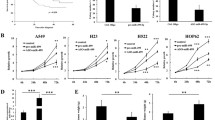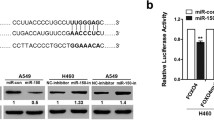Abstract
Activating protein-4 (AP4) has been recently shown to regulate the cancer metastases in some cancers including non-small cell lung cancer (NSCLC). Specifically, AP4 regulates mTor/p21 and transforming growth factor β (TGFβ) receptor signaling pathway to increase an epithelial-mesenchymal transition process to augment cell invasiveness. Nevertheless, how AP4 is regulated in NSCLC has not been studied. Here, we showed that in the specimens from the NSCLC patients, the levels of miR-144 were significantly decreased and the levels of AP4 were significantly increased, compared to the paired non-tumor lung tissue. The levels of miR-144 and AP4 inversely correlated in patients’ specimens. Bioinformatics analyses revealed that miR-144 targeted the 3′-UTR of AP4 mRNA to inhibit its translation, confirmed by luciferase-reporter assay. Moreover, miR-144 overexpression inhibited AP4-mediated cell invasiveness, while miR-144 depletion increased AP4-mediated cell invasiveness in NSCLC cells. Together, our data suggest that miR-144 suppression may be the cause of the increased levels of AP4, as well as the augmented cancer metastases, in NSCLC.





Similar content being viewed by others
References
Mitsudomi T, Suda K, Yatabe Y. Surgery for NSCLC in the era of personalized medicine. Nat Rev Clin Oncol. 2013;10:235–44.
Pallis AG, Syrigos KN. Epidermal growth factor receptor tyrosine kinase inhibitors in the treatment of NSCLC. Lung Cancer. 2013;80:120–30.
Zarogoulidis K, Zarogoulidis P, Darwiche K, Boutsikou E, Machairiotis N, Tsakiridis K, et al. Treatment of non-small cell lung cancer (NSCLC). J Thorac Dis. 2013;5:S389–96.
Jian H, Zhao Y, Liu B, Lu S. Sema4b inhibits growth of non-small cell lung cancer in vitro and in vivo. Cell Signal. 2015;27:1208–13.
Jian H, Zhao Y, Liu B, Lu S. Sema4b inhibits mmp9 to prevent metastasis of non-small cell lung cancer. Tumour Biol. 2014;35:11051–6.
Liu G, Xu S, Jiao F, Ren T, Li Q. Vascular endothelial growth factor b coordinates metastasis of non-small cell lung cancer. Tumour Biol. 2015;36:2185–91.
Lv Q, Shen R, Wang J. RBPJ inhibition impairs the growth of lung cancer. Tumour Biol. 2015;36:3751–6.
Pei J, Lou Y, Zhong R, Han B. MMP9 activation triggered by epidermal growth factor induced foxo1 nuclear exclusion in non-small cell lung cancer. Tumour Biol. 2014;35:6673–8.
Zhao D, Lu Y, Yang C, Zhou X, Xu Z. Activation of FGF receptor signaling promotes invasion of non-small-cell lung cancer. Tumour Biol. 2015;36:3637–42.
Bernardini N, Giannessi F, Bianchi F, Dolfi A, Lupetti M, Citti L, et al. Involvement of basic fibroblast growth factor in suramin-induced inhibition of v79/AP4 fibroblast cell proliferation. Br J Cancer. 1993;67:1209–16.
Shi L, Jackstadt R, Siemens H, Li H, Kirchner T, Hermeking H. P53-induced mir-15a/16-1 and AP4 form a double-negative feedback loop to regulate epithelial-mesenchymal transition and metastasis in colorectal cancer. Cancer Res. 2014;74:532–42.
Jackstadt R, Jung P, Hermeking H. AP4 directly downregulates p16 and p21 to suppress senescence and mediate transformation. Cell Death Dis. 2013;4:e775.
Jackstadt R, Roh S, Neumann J, Jung P, Hoffmann R, Horst D, et al. AP4 is a mediator of epithelial-mesenchymal transition and metastasis in colorectal cancer. J Exp Med. 2013;210:1331–50.
Jackstadt R, Hermeking H. AP4 is required for mitogen- and c-myc-induced cell cycle progression. Oncotarget. 2014;5:7316–27.
Jung P, Menssen A, Mayr D, Hermeking H. AP4 encodes a c-myc-inducible repressor of p21. Proc Natl Acad Sci U S A. 2008;105:15046–51.
Goc A, Al-Azayzih A, Abdalla M, Al-Husein B, Kavuri S, Lee J, et al. P21 activated kinase-1 (pak1) promotes prostate tumor growth and microinvasion via inhibition of transforming growth factor beta expression and enhanced matrix metalloproteinase 9 secretion. J Biol Chem. 2013;288:3025–35.
Chiang YA, Shao W, Xu XX, Chernoff J, Jin T. P21-activated protein kinase 1 (pak1) mediates the cross talk between insulin and beta-catenin on proglucagon gene expression and its ablation affects glucose homeostasis in male c57bl/6 mice. Endocrinology. 2013;154:77–88.
Gong H, Han S, Yao H, Zhao H, Wang Y. AP4 predicts poor prognosis in nonsmall cell lung cancer. Mol Med Rep. 2014;10:336–40.
Wang W, Wu X, Tian Y. Crosstalk of AP4 and TGFbeta receptor signaling in NSCLC. Tumour Biol. 2015;36:447–52.
Mei Q, Li F, Quan H, Liu Y, Xu H. Busulfan inhibits growth of human osteosarcoma through mir-200 family microRNAs in vitro and in vivo. Cancer Sci. 2014;105:755–62.
Chang Y, Zhao Y, Gu W, Cao Y, Wang S, Pang J, et al. Bufalin inhibits the differentiation and proliferation of cancer stem cells derived from primary osteosarcoma cells through mir-148a. Cell Physiol Biochem. 2015;36:1186–96.
Ji D, Li B, Shao Q, Li F, Li Z, Chen G. MiR-22 suppresses BMP7 in the development of cirrhosis. Cell Physiol Biochem. 2015;36:1026–36.
Song W, Li Q, Wang L, Wang L. Modulation of foxo1 expression by mir-21 to promote growth of pancreatic ductal adenocarcinoma. Cell Physiol Biochem. 2015;35:184–90.
Wang Q, Cai J, Wang J, Xiong C, Zhao J. Mir-143 inhibits EGFR-signaling-dependent osteosarcoma invasion. Tumour Biol. 2014;35:12743–8.
Leva G, Croce CM. MiRNA profiling of cancer. Curr Opin Genet Dev. 2013;23:3–11.
Pereira DM, Rodrigues PM, Borralho PM, Rodrigues CM. Delivering the promise of miRNA cancer therapeutics. Drug Discov Today. 2013;18:282–9.
Cao T, Li H, Hu Y, Ma D, Cai X. Mir-144 suppresses the proliferation and metastasis of hepatocellular carcinoma by targeting e2f3. Tumour Biol. 2014;35:10759–64.
Guan H, Liang W, Xie Z, Li H, Liu J, Liu L, et al. Down-regulation of mir-144 promotes thyroid cancer cell invasion by targeting zeb1 and zeb2. Endocrine. 2015;48:566–74.
Guo Y, Ying L, Tian Y, Yang P, Zhu Y, Wang Z, et al. Mir-144 downregulation increases bladder cancer cell proliferation by targeting EZH2 and regulating Wnt signaling. FEBS J. 2013;280:4531–8.
Iwaya T, Yokobori T, Nishida N, Kogo R, Sudo T, Tanaka F, et al. Downregulation of mir-144 is associated with colorectal cancer progression via activation of mTOR signaling pathway. Carcinogenesis. 2012;33:2391–7.
Akiyoshi S, Fukagawa T, Ueo H, Ishibashi M, Takahashi Y, Fabbri M, et al. Clinical significance of mir-144-zfx axis in disseminated tumour cells in bone marrow in gastric cancer cases. Br J Cancer. 2012;107:1345–53.
Kalimutho M, Del Vecchio Blanco G, Di Cecilia S, Sileri P, Cretella M, Pallone F, et al. Differential expression of mir-144* as a novel fecal-based diagnostic marker for colorectal cancer. J Gastroenterol. 2011;46:1391–402.
Giard DJ, Aaronson SA, Todaro GJ, Arnstein P, Kersey JH, Dosik H, et al. In vitro cultivation of human tumors: establishment of cell lines derived from a series of solid tumors. J Natl Cancer Inst. 1973;51:1417–23.
Liang CC, Park AY, Guan JL. In vitro scratch assay: a convenient and inexpensive method for analysis of cell migration in vitro. Nat Protoc. 2007;2:329–33.
Conflict of interest
None.
Author information
Authors and Affiliations
Corresponding author
Additional information
The Publisher and Editor retract this article in accordance with the recommendations of the Committee on Publication Ethics (COPE). After a thorough investigation we have strong reason to believe that the peer review process was compromised.
An erratum to this article is available at http://dx.doi.org/10.1007/s13277-017-5487-6.
About this article
Cite this article
Gao, F., Wang, T., Zhang, Z. et al. RETRACTED ARTICLE: Regulation of activating protein-4-associated metastases of non-small cell lung cancer cells by miR-144. Tumor Biol. 37, 15535–15541 (2016). https://doi.org/10.1007/s13277-015-3866-4
Received:
Accepted:
Published:
Issue Date:
DOI: https://doi.org/10.1007/s13277-015-3866-4




